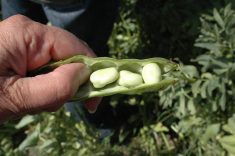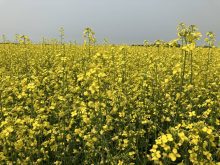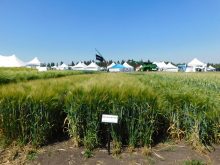With a reasonable harvest complete, Viterra’s bean plants at Taber and Bow Island have switched to their winter work, cleaning and shipping beans.
“It’s turned out not too bad a year, though our yields are down a bit,” says Taber plant manager Owen Clelland. “A few fields were hurt by a late frost, but quite a few were hit with rains that amounted to as much as 2.5 inches in mid-August, right after they’d irrigated. Beans don’t like to be wet and we saw a fair bit of white mould (sclerotinia) that cut yields down by 100 to 150 lbs.”
Read Also

New crop insurer policy enables easier startup for faba beans
Agriculture Financial Services Corporation updated its normals for faba beans, which may open the door for more Canadian producers to feel comfortable growing the pulse crop in the future.
The rain tested a new variety of great northerns that is less susceptible to sclerotinia. Resolute stood up well and had the best average yield at 2,250 lbs./acre.
Clelland says Viterra is generally conservative in its market estimates. This year, it contracted 42,000 acres, mostly pintos and great northerns, 34,000 acres between them. Reds, blacks, and pinks accounted for a total of 7,000 acres and the company also tried a new variety of yellow beans called Mayacumba. It’s very much in demand, but seed of the ADM variety is very limited.
Over the years, beans have paid a lot of bills in southern Alberta. Clelland should know. His father, Walter, set up the first bean plant in Alberta. Young Owen always had an after-school job, filling and loading 100-lb. bean sacks into trucks, with no labour-saving devices like pallet jacks. Beans are still shipped in bags, especially to offshore markets, although 50-lb. bags are becoming more popular than the 100-lb. ones in most markets.
Great Northerns are shipped mainly to Mediterranean countries, where Greece is the biggest customer, along with Turkey, the Arab countries and North Africa. About half the pinto beans produced in southern Alberta are shipped to the southwestern U.S., where there’s a large Hispanic population. Alberta beans are preferred to those grown in Minnesota and the Dakotas because our drier weather helps Canadian growers take off a better-quality crop.
BLACKS UP, REDS DOWN
There’s a huge market for Canadian pinto beans in the Caribbean, especially the Dominican Republic. Clelland says Viterra staff have developed a close relationship with bean growers and marketers there. They’ve helped them acquire equipment and learn better production techniques. One staff member is taking his accumulated holidays this winter so he and his wife can work with Dominican growers.
Markets for black beans are increasing and Viterra will probably ramp up acreage next year. Those beans are sold into Mexico and the southwestern U.S. On the other hand, Alberta red beans are finding fewer buyers. Their main market is Colombia, which has signed a free trade agreement with the U.S., so Canadian beans face steep tariffs. Canada has negotiated a free trade deal with Colombia, but it is not in effect because it has not been ratified.
“We grew 10,000 or 12,000 acres of reds at one time,” says Clelland. “The next year it dropped to 2,500 acres. They buy American beans now and we probably won’t grow any next year. Colombia used to come to Canada for lentils, chickpeas and peas as well, but our crops face a steep import tax. They buy from the U.S. now.”
Clelland says personal relationships, often with family companies, are key to making deals in pulse markets. So far, those close relationships are working in favour of southern Alberta farmers, particularly in the Dominican Republic, but how long these relationships will trump U.S. free trade deals is questionable.
To maintain the high quality of Alberta beans, Viterra has a cleaning process that leaves beans bright and attractive. First they’re air sorted to clean out splits and lights, then sorted on a gravity table to sort the beans by weight. Stones are cleaned out and lastly colour is checked. Beans are then packed in mini-bulk totes, 100-or 50-lb. bags or for some U.S. buyers, bulk containers.
The Bow Island and Taber plants are certified to ISO14000. Farmers must provide assurance they have used only registered pesticides according to the labels to assure customers of the quality of the product.
But quality can’t always offset the lower U.S. price for buyers, says Clelland.
“Canada is way behind the U.S. in setting up free trade agreements with Third World countries. It’s cost us markets already.”














